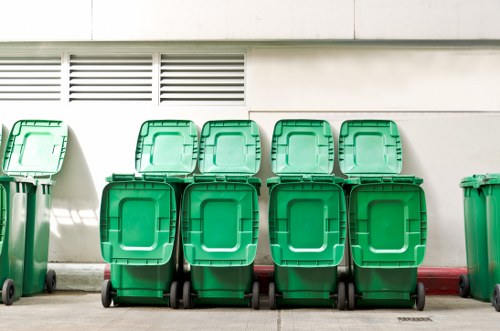Furniture Disposal in Waste Recycling

The Importance of Furniture Disposal
Proper furniture disposal plays a crucial role in waste recycling and environmental sustainability. By responsibly managing old and unwanted furniture, we can significantly reduce the amount of waste that ends up in landfills. This not only conserves valuable landfill space but also minimizes the environmental footprint associated with furniture production and disposal.
Moreover, effective furniture disposal promotes the reuse and recycling of materials, ensuring that valuable resources such as wood, metal, and fabrics are recovered and repurposed. This process helps in conserving natural resources and reduces the need for new raw materials, thereby supporting a circular economy.
Additionally, proper disposal methods can prevent harmful substances found in some furniture, like certain chemicals and flame retardants, from contaminating the environment. This safeguards both ecological systems and human health.

Methods of Furniture Disposal
Donation
Donating furniture is an excellent way to extend its lifecycle and benefit those in need. Many charitable organizations and non-profits accept gently used furniture, refurbishing it before making it available to individuals and families who may not have the means to purchase new items. This method promotes community support and reduces waste.
Benefits of Donation:
- Supports charitable causes
- Reduces landfill waste
- Provides affordable furniture options
Before donating, ensure that the furniture is in good condition and check with the organization for any specific requirements or restrictions.

Recycling
Recycling furniture involves breaking down items into their constituent materials for reuse in manufacturing new products. This method is particularly effective for furniture made of recyclable materials like wood, metal, and certain plastics. Recycling furniture helps in conserving natural resources and reduces the energy consumption associated with producing new materials.
Recycling Process:
- Collection of old furniture
- Sorting materials
- Processing and manufacturing
Not all furniture can be recycled, so it's essential to consult with local recycling centers to determine which items are accepted.

Repurposing
Repurposing involves creatively transforming old or unwanted furniture into new, functional items. This sustainable approach not only gives a second life to furniture pieces but also allows for personalization and customization. For example, an old dresser can be converted into a stylish bookshelf or a vintage chair can be upcycled with a fresh coat of paint and new upholstery.
Advantages of Repurposing:
- Encourages creativity
- Reduces waste
- Provides unique, customized pieces
Repurposing requires some DIY skills but can be a rewarding way to contribute to waste recycling efforts.

Disposal Services
When furniture cannot be donated, recycled, or repurposed, professional disposal services are the next best option. These services ensure that furniture is disposed of responsibly, adhering to local regulations and environmental standards. Many disposal companies offer pickup services, making the process convenient for homeowners and businesses alike.
Choosing a Disposal Service:
- Verify licensing and certifications
- Inquire about recycling practices
- Compare pricing and services offered
Opting for a reputable disposal service helps ensure that your furniture is handled in an environmentally friendly manner.

Benefits of Proper Furniture Recycling
Engaging in proper furniture recycling offers numerous benefits for both the environment and society. By recycling, we can significantly decrease the volume of waste destined for landfills, thereby prolonging their lifespan and reducing the associated environmental hazards.
Furthermore, recycling furniture conserves natural resources by reusing materials that would otherwise require new extraction and processing. This conservation effort reduces the energy consumption and carbon emissions tied to manufacturing new products, contributing to the fight against climate change.
Additionally, recycling supports the creation of green jobs in the recycling and manufacturing sectors, fostering economic growth and sustainability.

How to Recycle Different Types of Furniture
Wood Furniture
Wooden furniture is highly recyclable due to its natural properties. The recycling process typically involves dismantling the furniture, treating any finishes or stains, and processing the wood into reusable materials. Recycled wood can be used in the production of new furniture, flooring, or as raw material for paper products.
- Ensure the wood is free from toxic finishes
- Remove hardware and non-wood components
- Consult with local recycling centers for guidelines
Recycling wood furniture not only reduces waste but also supports sustainable forestry practices.

Metal Furniture
Metal furniture, including items made from steel, aluminum, and other metals, is highly recyclable and often contains a high percentage of recycled materials. The recycling process for metal furniture involves collection, sorting, cleaning, and melting down the metals to be reused in new manufacturing processes.
Steps to Recycle Metal Furniture:
- Separate metal parts from other materials
- Clean the metal to remove any contaminants
- Take the metal to a facility that processes recyclable metals
Recycling metal furniture helps in conserving resources and reducing the environmental impact of metal extraction.

Upholstered Furniture
Upholstered furniture, such as sofas and chairs, can be more challenging to recycle due to the combination of materials used, including fabrics, foam, and metal or wood frames. However, there are still environmentally friendly ways to dispose of upholstered items.
Recycling Upholstered Furniture:
- Donate to organizations that specialize in refurbishing plush items
- Separate and recycle individual components, such as frames and fabrics
- Consider professional recycling services that handle complex furniture materials
Properly recycling upholstered furniture helps in minimizing waste and promoting the reuse of valuable materials.

Challenges in Furniture Recycling
Contamination
One of the primary challenges in furniture recycling is contamination. Furniture items contaminated with hazardous substances, such as certain chemicals, paints, or adhesives, can pose significant environmental and health risks if not handled properly. Contaminated materials require special treatment, increasing the complexity and cost of recycling processes.
- Ensure furniture is free from hazardous chemicals before recycling
- Seek professional cleaning services if necessary
- Educate consumers on the importance of clean recycling practices
Addressing contamination is essential for maintaining the integrity and effectiveness of furniture recycling programs.

Logistics
Logistical challenges, such as transportation and collection, can hinder effective furniture recycling. Large and bulky items require appropriate handling and transport, which can be resource-intensive. Additionally, the lack of accessible recycling facilities in certain areas may limit the availability of recycling options for consumers.
Overcoming Logistical Barriers:
- Partner with local recycling services for efficient collection
- Utilize drop-off centers for convenient recycling
- Promote local recycling initiatives to increase accessibility
Improving logistical aspects is key to enhancing the overall effectiveness of furniture recycling efforts.

Tips for Effective Furniture Disposal
Assess the Condition
Before deciding on a disposal method, thoroughly assess the condition of your furniture. Items that are still in good shape may be suitable for donation or resale, while those that are damaged or worn out might be better candidates for recycling or professional disposal services.
Steps to Assess:
- Check for structural integrity
- Identify any damages or stains
- Determine if repairs or cleaning are feasible
Proper assessment helps in selecting the most appropriate and environmentally friendly disposal method.

Choose the Right Method
Selecting the appropriate disposal method depends on the item's condition, material, and your personal preferences. Consider factors such as environmental impact, cost, and convenience when making your decision.
Considerations:
- Is the item still usable or repairable?
- What materials is the furniture made of?
- Are there local recycling or donation options available?
By carefully choosing the right method, you contribute to effective waste recycling and environmental conservation.

Schedule Regular Disposal
Mistakenly allowing furniture to accumulate can lead to increased waste and clutter. Scheduling regular disposal times helps in managing space efficiently and ensures that old items are removed promptly and responsibly.
- Set aside specific times for disposal and recycling
- Coordinate with disposal services for regular pickups
- Stay organized to minimize accumulation of unwanted furniture
Regularly scheduling disposal activities promotes a cleaner, more sustainable living or working environment.

Choosing a Furniture Disposal Service
What to Look For
When selecting a professional furniture disposal service, it's important to consider several key factors to ensure that your disposal needs are met responsibly and efficiently.
Key Factors:
- Environmental certifications and compliance
- Range of services offered
- Customer reviews and reputation
Choosing a service that prioritizes sustainable practices ensures that your furniture is disposed of in an eco-friendly manner.

Questions to Ask
Before finalizing a disposal service, ask specific questions to gauge their reliability and commitment to waste recycling principles.
- How do you handle recyclable materials?
- Are there any fees associated with your services?
- Can you provide references or testimonials?
These questions help in selecting a trustworthy disposal service that aligns with your sustainability goals.

Compare Pricing and Services
Different disposal services offer varying pricing structures and service packages. It's essential to compare these aspects to find a service that fits your budget while meeting your disposal needs.
Comparison Tips:
- Request quotes from multiple providers
- Evaluate the inclusiveness of the services offered
- Consider any additional benefits or guarantees
Making an informed comparison ensures that you receive value for your investment in furniture disposal services.

Conclusion
Effective furniture disposal is a pivotal component of waste recycling and environmental stewardship. By understanding the various disposal methods, benefits, and challenges, individuals and businesses can make informed decisions that promote sustainability and reduce waste.
Whether through donation, recycling, repurposing, or professional disposal services, responsibly managing old furniture not only conserves resources but also fosters a healthier planet. Embracing these practices contributes to a circular economy, where materials are continually reused and repurposed.
Take Action Today: Don't let unwanted furniture clutter your space and harm the environment. Contact us today or book your service now to ensure your furniture disposal aligns with sustainable waste recycling practices.